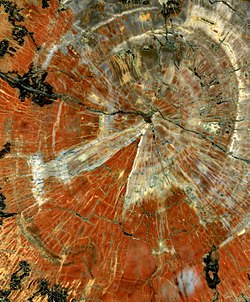Portal:Paleontology
|
The Palaeontology Portal
Introduction Paleontology (/ˌpeɪliɒnˈtɒlədʒi, ˌpæli-, -ən-/ PAY-lee-on-TOL-ə-jee, PAL-ee-, -ən-), also spelled palaeontology or palæontology, is the scientific study of life that existed prior to the start of the Holocene epoch (roughly 11,700 years before present). It includes the study of fossils to classify organisms and study their interactions with each other and their environments (their paleoecology). Paleontological observations have been documented as far back as the 5th century BC. The science became established in the 18th century as a result of Georges Cuvier's work on comparative anatomy, and developed rapidly in the 19th century. The term has been used since 1822 formed from Greek παλαιός ('palaios', "old, ancient"), ὄν ('on', (gen. 'ontos'), "being, creature"), and λόγος ('logos', "speech, thought, study"). Paleontology lies on the border between biology and geology, but it differs from archaeology in that it excludes the study of anatomically modern humans. It now uses techniques drawn from a wide range of sciences, including biochemistry, mathematics, and engineering. Use of all these techniques has enabled paleontologists to discover much of the evolutionary history of life, almost back to when Earth became capable of supporting life, nearly 4 billion years ago. As knowledge has increased, paleontology has developed specialised sub-divisions, some of which focus on different types of fossil organisms while others study ecology and environmental history, such as ancient climates. (Full article...) Selected article on the prehistoric world and its legacies
Diplodocus (meaning 'double bar') is a genus of diplodocid sauropod dinosaur whose fossilised skeleton was first discovered in 1878. The generic name refers to its double-beamed chevron bones (Greek diplos/διπλος meaning 'double' and dokos/δοκος meaning 'wooden beam' or 'bar') located in the underside of the tail. They were initially believed to be unique to Diplodocus; however, they have since then been discovered in other diplodocids.
It lived in what is now western North America at the end of the Jurassic Period. Diplodocus was one of the more common dinosaurs found in the Upper Morrison Formation, about 150 to 147 million years ago, in what is now termed the Kimmeridgian and Tithonian stages. This was an environment and time dominated by gigantic sauropod dinosaurs such as Camarasaurus, Barosaurus, Apatosaurus and Brachiosaurus. Diplodocus is among the most easily identifiable dinosaurs, with its classic dinosaur shape, long neck and tail and four sturdy legs. For many years, it was the longest dinosaur known. Its great size may have been a deterrent to the predators Allosaurus and Ceratosaurus: their remains have been found in the same strata, which suggests they coexisted with Diplodocus. (see more...) Did you know?

General images -The following are images from various paleontology-related articles on Wikipedia.
Selected article on paleontology in human science, culture and economics
There have been a number of potential species assigned to the carnosaurian dinosaur genus Allosaurus since its description in 1877 by Othniel Charles Marsh, but only a handful are still regarded as valid. Allosaurus was originally described from material from the Upper Jurassic Morrison Formation of the western United States of America; the type species A. fragilis became one of the best-known species of dinosaur.
The genus Allosaurus was part of the Marsh/Cope "Bone Wars" of the late 19th century, and its taxonomy became increasingly confused due to the competition, with several genera and species named by Cope and Marsh now regarded as synonyms of Allosaurus or A. fragilis. Since the description of Allosaurus, scientists have proposed additional species from such far-flung locales as Portugal, Siberia, Switzerland, and Tanzania, and unnamed remains from Australia and China have also been assigned to the genus at one time or another. (see more...) On this day...May 31:
Selected image
CategoriesTopicsGeneral - Paleontology - Fossil - Evolution - Extinction Quality ContentFeatured paleontology articles
- Achelousaurus
- Acrocanthosaurus
- Albertosaurus
- Allosaurus
- Amargasaurus
- Ankylosaurus
- Apatosaurus
- Archaeopteryx
- Baryonyx
- Carnotaurus
- Catopsbaatar
- Ceratosaurus
- Chicxulub Crater
- Compsognathus
- Cretaceous–Tertiary extinction event
- Daspletosaurus
- Deinocheirus
- Deinonychus
- Deinosuchus
- Dilophosaurus
- Dinosaur
- Diplodocus
- Dromaeosauroides
- Edmontosaurus
- Elasmosaurus
- Giganotosaurus
- Gorgosaurus
- Herrerasaurus
- Iguanodon
- Istiodactylus
- Lambeosaurus
- List of dinosaur genera
- Majungasaurus
- Massospondylus
- Megalodon
- Nemegtomaia
- Nigersaurus
- Opisthocoelicaudia
- Paranthodon
- Parasaurolophus
- Plateosaurus
- Psittacosaurus
- Seorsumuscardinus
- Spinosaurus
- Stegosaurus
- Stegoceras
- Styracosaurus
- Tarbosaurus
- Thescelosaurus
- Triceratops
- Tyrannosaurus
- Velociraptor
Things you can doCurrent Paleontology FACs - None yet... WikiProjectsRelated portalsAssociated WikimediaThe following Wikimedia Foundation sister projects provide more on this subject:
Discover Wikipedia using portals |









































